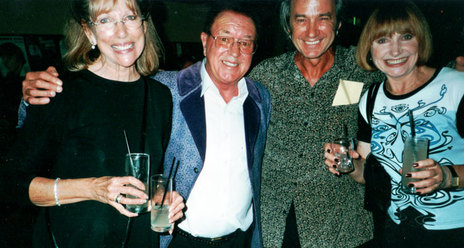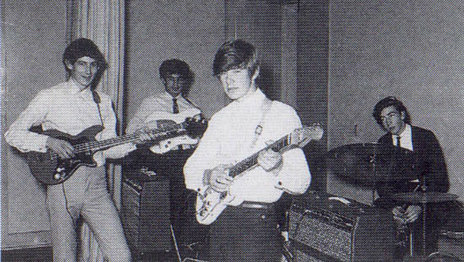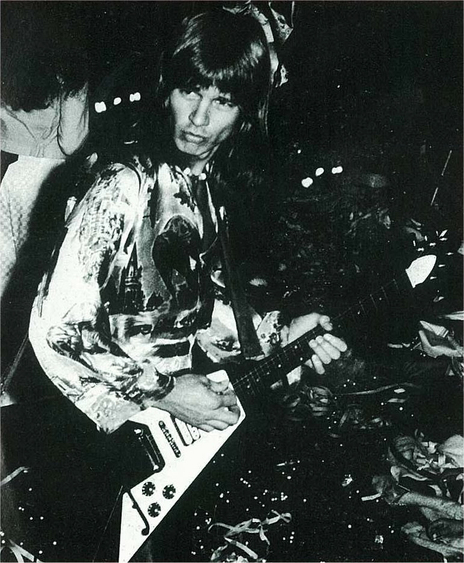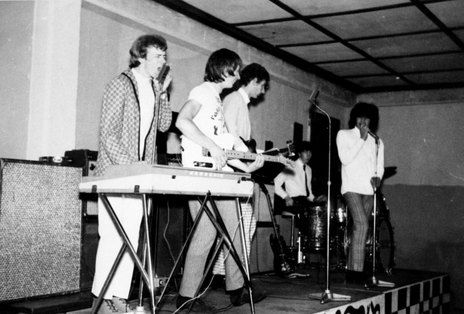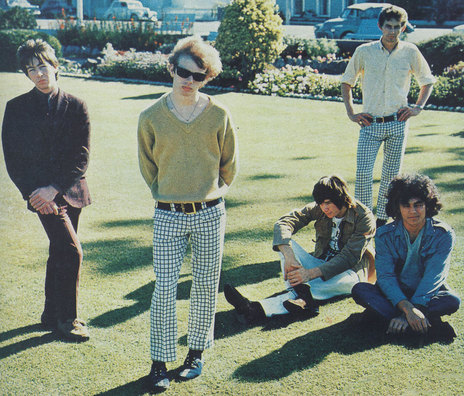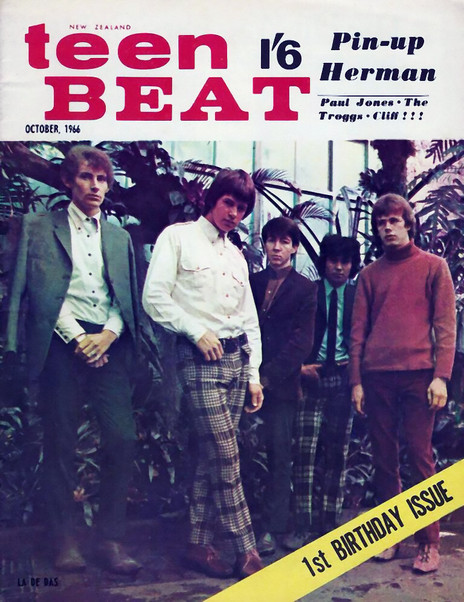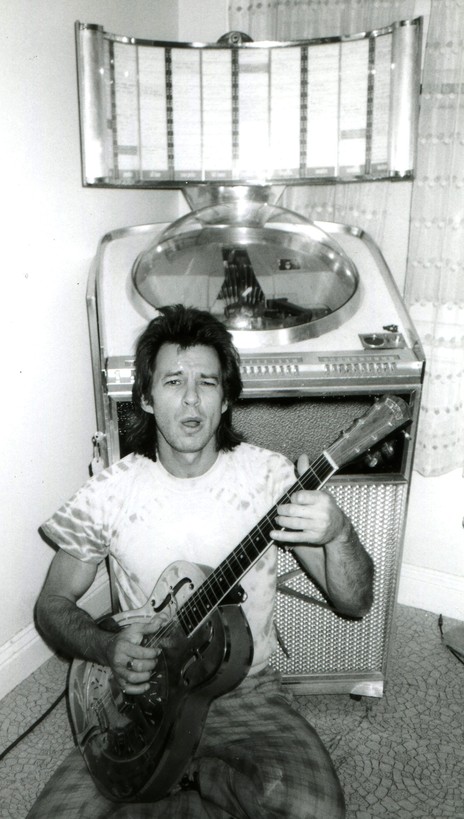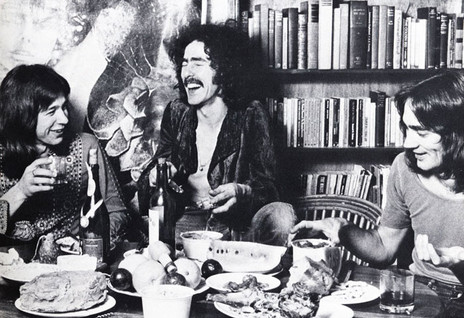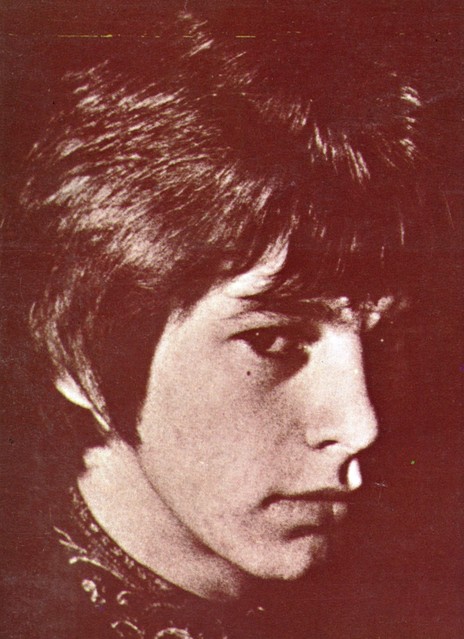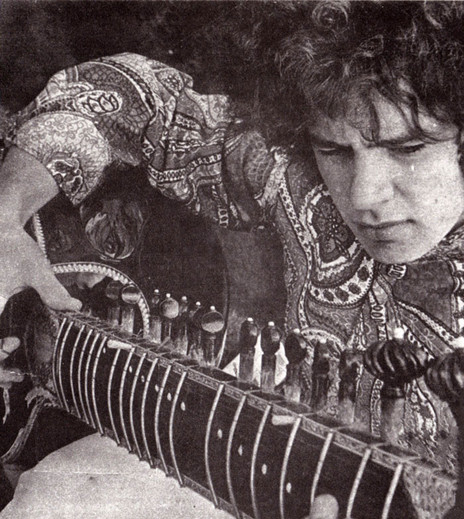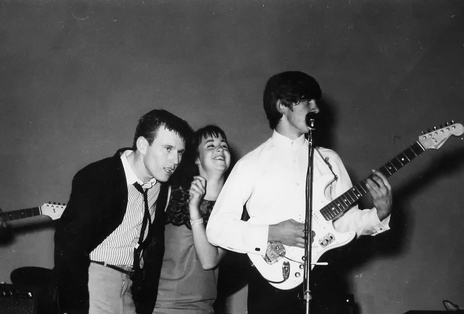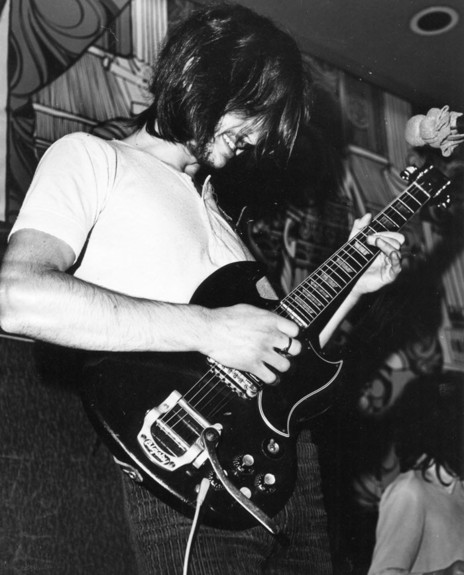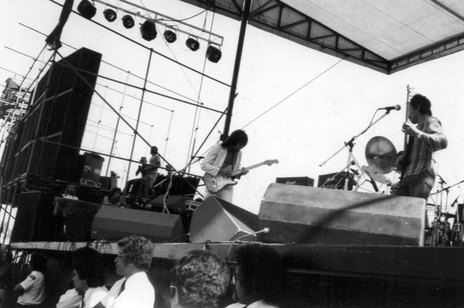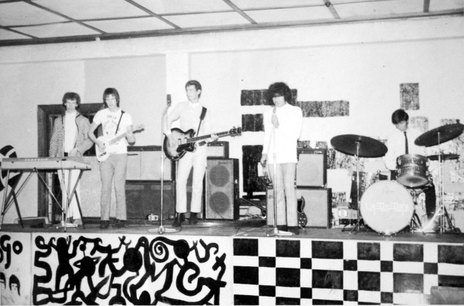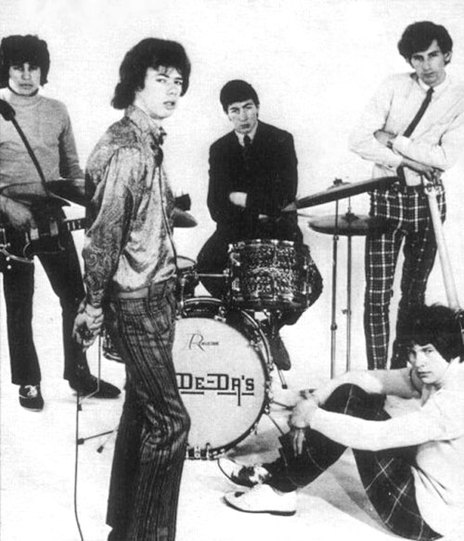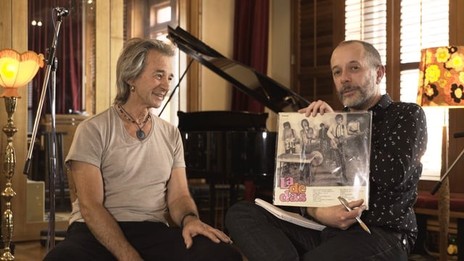Accolades like world-class, guitar god, guitar playing legend, guitar hero, guitar hero supremo, Australia’s premier gun guitarist have all been used to describe him. Santana said of Borich: “He’s amazing. He sounds so much like Jimi Hendrix yet has an individual style. He presents his music honestly and is one of the best guitarists I’ve heard.”
When Borich was a schoolboy, his Auntie Joni owned some Ray Charles records and had American friends. It was through her that he first came to hear the blues: Ray Charles, John Lee Hooker, Muddy Waters. “She opened the door for me. I loved Ray Charles that early and was mesmerised by John Lee Hooker’s ‘Tupelo’ – a song about the tragic, mighty Mississippi flood. It’s steeped in the deepest emotion.”
At 12 or 13 his mother took him to see Johnny Devlin at the Auckland Town Hall. Recently Devlin went to one of his shows in NSW. The two got to chat that night and Borich told the master just how important seeing him was all those years ago.
Aged 12 Borich made his first recording singing ‘I’m Gonna Knock On Your Door’, some Elvis songs and several others that were popular then. The Chicks (Judy and Sue Donaldson) were next door neighbours; they sang harmonies on the record.
At high school he sought out like-minded lads who wanted to be in a band. This led to the formation of The Mergers with Trevor Wilson (bass) and drummer Brett Neilsen. It was thanks to Wilson’s mother that they became The La De Da’s. She wouldn’t allow her son to be in a band called The Criminals. “Call yourselves something nice,” she said. “Like ... like The La De Da’s.” So they did.
In their very early days they used to go to the Shiralee to watch either Max Merritt and The Meteors or Ray Columbus and The Invaders. One night they were both on. “How about that for an education?” says Borich.
Phil Key joined The La De Da’s on rhythm. “He was a fantastic rhythm player,” says Borich. “He wasn’t pushing himself to sing until we had Steve Winwood’s ‘Gimme Some Loving’ to cover. Trevor’s looking at me. I’m looking at Trevor and Bruce was in the band then too. The four of us knew we couldn’t do it justice then Phil piped up, ‘I’ll have a go’. And we were astounded.”
So they had their lead singer. The band then was Phil Key (rhythm guitar and vocals); Kevin Borich (lead guitar); Trevor Wilson (bass); Brett Neilsen (drums) and Bruce Howard (keyboards).
Despite Phil Key’s protests they prostituted themselves with their first television performance. They sang ‘Those Magnificent Men In Their Flying Machines’ with its “up-diddly-up-up” refrain when the movie was due for release, because by doing that they would get to record a single. Wilson and Borich wrote the rocker ‘Little Girl’ for the A-side. Kevin’s ‘Ever Since That Night’ was on the flip of the Talent City record. The B-side has a mournful harmonica mirroring the sadness in the song.
Borich: “You know what. I’d just learnt a major 7th chord which I called ‘the love chord’ (and I still do) and I went all gooey.” The A-side was played on air but in 1965 the NZBC wasn't happy with his lyrics about the girl and boy making love in the back of his car.
The band got their first break when they filled in for The Dallas Four at The Platterack in Durham St, Auckland, then got the residency there. This toughened them up in many ways. They worked long hours. Downstairs they played until midnight then they lugged their gear up the narrow stairs to play to an alternative crowd of trannies and prostitutes and other people who came out in the wee small hours. “We were playing Top 20 stuff but picking out what we thought was cool and more R&B. And The Rolling Stones of course. We liked those naughty Rolling Stones boys.”
Visually, the five of them were so different from their contemporaries, who wore suits and ties.
Visually, the five of them were so different from their contemporaries, who wore suits and ties. The La De Da’s wore mod clothes as English groups like The Rolling Stones did. At first the guys bought clothes from second-hand shops but once they had some money they got clothes made. Many will remember their ultra-sexy tartan trousers era.
‘How Is The Air Up There’ was released in 1966. It presented the country with a fierce keyboard-driven sound and a massive fuzz box riff, from a New Zealand group who were all still teenagers. It reached No.4 on the NZ music charts and was in the final 10 entries for the Loxene Golden Disc contest in 1966. Many people believed it should have won. It was certainly the best of the songs in the competition but the pattern was to reward something MOR, something nice. ‘Air’ could never be labelled nice with Kevin playing its riff through that fuzz box, a first in New Zealand.
Later in 1966 ‘On Top Of The World’ was released. It reached No.2 where it stayed for three weeks. These lads meant business. They changed residencies, moving to the Galaxie and were there at the same time as The Pleazers.
Just before Christmas 1966, The La De Da’s’ self-titled album was released. Extremely popular, it sold rapidly. Early in 1967 the pleading ‘Hey Baby’ (with its camp “Hello” from Wilson in the break) was released, giving the band a No.1 placing on the NZ music charts.
From as early as the recording of their second album Find Us A Way in 1967, Borich’s exquisite talent as a guitarist was becoming obvious. Trevor Wilson had written about each song for the cover notes. He noted of the track Find Us A Way: “Full marks to Kevin on his superb guitar solo.” Borich still handled some of the vocals. Wilson, of the song ‘I Gotta Woman’ sung by Borich, commented that he was showing his versatility. Borich also delivered a Georgie Fame-like rendition of ‘Sonny Boy’ on this album.
That was the year the band first went to Australia. Borich: “The thing I’ve got to say about those days was that the world was so big. Then, to get on a plane and go to Australia was a big deal. Now you’d go to America because of the huge population, and in this game, the bigger population gives more chance of doing well. We just did what Ray and Max did. And it’s been great.”
The 1967 trip to Sydney didn’t last long. They returned to NZ to earn some money. Funds replenished, they returned to Australia again in 1968 without Neilsen. This was the first of many changes in their line-up.
1969 brought two major events: the release of The Happy Prince album and their trip to London. The album wasn’t especially well received, but of the track ‘Lullaby’, rock critic Iain McIntyre commended Borich's masterful sitar playing. Borich retorted that he wasn’t a master, but agreed it did sound pretty nice.
Roadie Wayne Jarvis (Swampy to his friends) accompanied the band when they went to the UK, where his role expanded into tour manager. They had saved some money to do the trip but it was brief and not especially successful. They were not able to record any original songs but were allowed a cover. At EMI they were presented with the opportunity to choose a Beatles song from their next LP (prior to its release). They chose ‘Come Together’, which got airplay on Radio Luxembourg, but The Beatles released it soon after.
As a four-piece late in 1971 Key, Borich, drummer Keith Barber and bassist Peter Hardinge recorded the song that was their most successful; the Borich-original ‘Gonna See My Baby Tonight’ which attained the No.16 position for the Top 20 Australian hits for 1972. Recorded with minimal rehearsal with NZ-born producer Howard Gable, it has a live, spontaneous, happy feel.
By the early 70s The La De Da’s were one of the three top live bands in Australia.
By the early 70s The La De Da’s were one of the three top live bands in Australia (alongside Billy Thorpe and The Aztecs and Daddy Cool). On Boxing Day 1971 the three bands played at an outdoor show in Rosebud on the Mornington Peninsula. This was a big event with something like 50,000 people present. The following month they played at the inaugural Sunbury Festival. Mike Rudd was also on the bill in both his Spectrum and Murtceps roles, as were Max Merritt and The Meteors. Rock journalist Murray Engleheart called the event “... a blazing showcase for The La De Da’s, who had morphed from their psychedelic roots in New Zealand to a white-hot blues-and-rock act with guitar god Kevin Borich.”
Just weeks later there was a third very successful outdoor show. This one was at the Myer Music Bowl in Melbourne with an audience of 200,000 people. Borich acknowledged this to be one of the highlights of his career, it was the biggest crowd he had ever performed to.
After Phil Key departed they became a trio with Borich on lead guitar, drummer Keith Barber (ex-Wild Cherries, who joined the band following Brian Harris’ short stint) and Ronnie Peel (ex-Pleazers) on bass. Within the three-piece band there were discussions about whether to get a singer. Borich thought he could do this and became the trio’s vocalist, noting at first the change in role was a challenge physically. By this time he was the lead singer and main songwriter. The slimmed down band “effectively became a platform for the increasingly breathtaking guitar-work of Kevin Borich,” commented noted rock archivist Ian D. Marks.
They released several singles and two albums. The rocking Chuck Berry’s ‘Too Pooped To Pop’ and ‘Morning Good Morning’ (written by Borich and Key) both charted. By this stage, they were working with New Zealand producer Rod Coe.
The first album, Rock And Roll Sandwich (1974), includes the track ‘The Place’ which was lifted as a single. Borich still plays it in shows sometimes. The second album, Legend, was released in 1975. But that year Borich knew the three of them were heading in different directions. “Like trees being seedlings you’ve got to separate them to grow.”
Following the break-up Borich toured with John Paul Young and his Allstars and in 1976 he formed Kevin Borich Express.
Following the break-up Borich toured with John Paul Young and his Allstars and in 1976 he formed Kevin Borich Express. Guitar legend Harry Brus was initially there on bass with Barry Harvey on drums. Over the years there have been lots of line-up changes and Borich’s son Lucius was their drummer at one stage.
1977 was a big year. Early in the year the band toured as support with Jeff Beck then in the latter part of the year they played two huge shows with Santana, Fleetwood Mac and Little River Band. This was when Borich was invited on stage to jam with Santana. Borich won the RAM (Rock Australia Magazine) Readers Polls award as Best Guitarist for 1977. The following year he won the same award again and went to the USA where the band recorded and toured.
From 1982 to 1989 he was in The Party Boys with Paul Christie (ex-Mondo Rock). Their membership was fluid but essentially they were a band of musicians who had seen previous success in the music industry. Marc Hunter (ex-Dragon) joined for a brief period. Although Party Boys was vibrant and successful too, for Borich working with them took time away from his own music. In 1990 he toured with Jimmy Barnes for part of the Two Fires tour.
In 2001 the ABC showed the series Long Way To The Top, telling the history of rock and roll in Australia and NZ from 1956. The following year the road show of acts from the series criss-crossed the country. Borich’s performance stood out and his playing was exceptional. Tony Barber (ex-Aztecs): “When Kevin ripped into a blistering guitar solo it was obvious ... that I was watching a true musician, fully at ease, in control, and the master of his instrument.”
Over the years Kevin Borich Express has supported international artists including Elton John, Status Quo, Buddy Guy, Peter Frampton and more recently they supported Eric Burdon and The Animals. Borich has performed on shows with greats like Ray Charles, Bo Diddley, Ronnie Wood, John Mayall, Joe Walsh and Tony Joe White.
Kevin Borich Express toured Europe and he has played on albums for people like Marc Hunter, Renee Geyer, Richard Clapton and Dutch Tilders.
He is best known for playing his “funkin’ rockin’ blues” and attracts blues and rock fans. Of his current repertoire he says, “It’s not all rock. Or blues. There are a few Latin songs. There’s some reggae. I just kinda like a lot of styles.”
Since 1976 he has written songs both for Kevin Borich Express and to do solo. ‘Gonna See My Baby Tonight’ is his best known song; he has written great songs like ‘Going Somewhere’; beautiful songs like ‘Saved By The Blues’ and crowd favourites “Heartstarter’ and ‘Downtown’. His 2014 album Totem includes the driving, deeply-impassioned ‘Fight’.
He has been recognised in Australia for his expertise. As well as the Best Guitarist awards noted above, he won the Heritage Award at the 1999 Australian Blues Music Festival and in 2003 was inducted into the Australian Blues Foundation Hall of Fame.
A diagnosis of nasopharyngeal squamous cell carcinoma pressed the pause button in 2005. He required radiation and chemotherapy. But he had to agree to do 60 dives at 14 fathoms. “It’s to stop bone disease happening; if radiated bone gets exposed to air you get this disease; the bones starts rotting.
“I did a show four weeks after my last chemo. It was only a 40 minute set supporting the Angels. I was as weak as a kitten but I managed to do it with minder/roadie help. But I fell in a heap afterwards.” His cancer and its treatment put him out of action for some time and left him with a loss of his salivary glands and some hearing loss. “But I’m lucky to be alive.”
He has performed at music festivals within Australia and overseas in spots including Fiji; Jakarta; Bali. During 2015 and 2016 he performed up and down the Australian east coast and in Tasmania. His shows start with an acoustic blues set on his lovely 1930s National guitar, followed by a high energy electric second set. In the latter he uses his US Custom Fender Stratocaster and a stunning Gibson Firebird guitar.
Borich attributes his strong work ethic to his parents and his passion. His father was born in New Zealand of Dalmatian (Croatian) parents. His mother came from the Dalmatian Coast aged five. Kevin explained how they worked hard from the day they put a £10 deposit on a broken down orchard, turning it into a highly successful, productive property.
The topic of longevity came up. “Yeah, I’ve been lucky to have that. A lot of great players have stopped playing or they passed away.”
He does yoga to keep fit and uses humour often. In response to the notion that the sounds made by the 1958 guitar substitute – the tennis racket – weren’t quite right, he quipped that the tennis racket was very hard to tune; it had a lot of strings.
